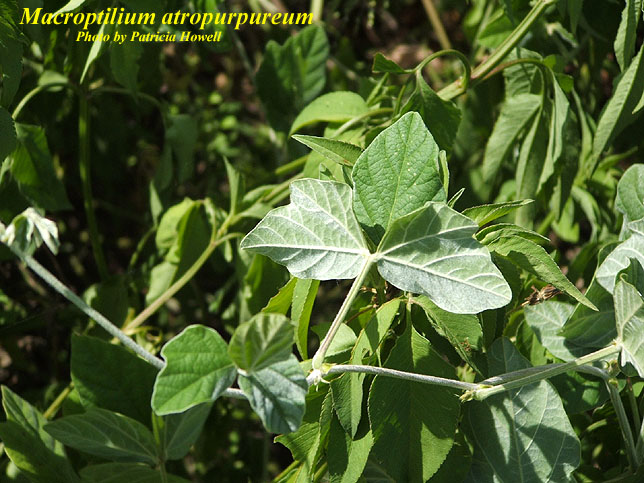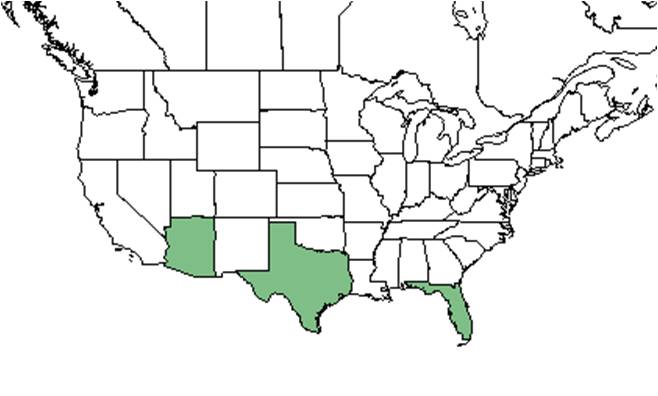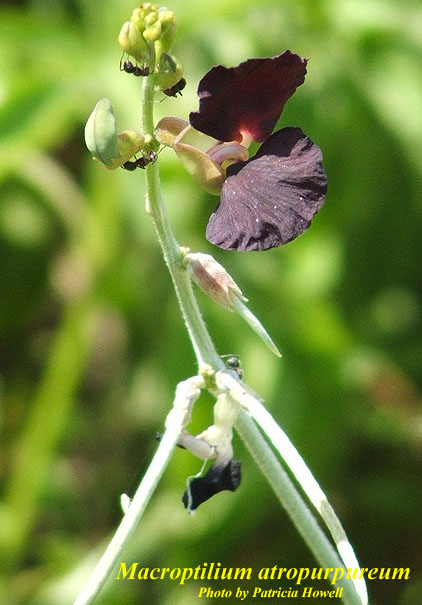Macroptilium atropurpureum
| Macroptilium atropurpureum | |
|---|---|

| |
| Photo by Patricia Howell, Atlas of Florida Vascular Plants | |
| Scientific classification | |
| Kingdom: | Plantae |
| Division: | Magnoliophyta - Flowering plants |
| Class: | Magnoliopsida – Dicotyledons |
| Order: | Ericales |
| Family: | Fabaceae |
| Genus: | Macroptilium |
| Species: | M. atropurpureum |
| Binomial name | |
| Macroptilium atropurpureum (Lam.) K. Koch | |

| |
| Natural range of Macroptilium atropurpureum from USDA NRCS Plants Database. | |
Common name: Purple bushbean
Contents
Taxonomic notes
Description
A perennial species in tropical regions and an annual in subtropical climates. It is a trailing, climbing, twining species with a deep, swollen taproot (Morris 2010).
Distribution
It is a native to tropical continental America, and is distributed through out the tropics [1].
Ecology
Habitat
Habitats include disturbed ruderal areas such as lawns, along railroad beds, and pastures (FSU Herbarium). It has great economic importance in cover crop, forage and prevents soil erosion (Cook et al. 2005). A long, deep taproot adn the ability to reduce evapotranspiration by shedding its leaves allows for toleration of dry conditions[2].
M. atropurpureum can be nodulated by a range of alpha-rhizobial strains, which allow for nitrogen-fixation and allowing the plants to thrive in nutrient poor soils. Soil, pH, phosphate, and CaCO3 content and granulation influence the type of rhizobial nodulation that occurs. When M. atropurpureum grows under dry, high temperature conditions, Burkholderia tuberum induced nitrogen fixing nodules (Angus et al. 2013).
Phenology
Flowers and fruits August through October (FSU Herbarium). It has been observed that flowering is initiated in response to the onset of dry periods and shortening days while vegetative growth resumes with the return of moist conditions[3].
In subtropical climates, it displays an annual lifecycle, while in tropical climate is perennial. Perennation of this species has been observed to be associated with survival of original crowns that develop from seedlings. Individuals that are produced by vegetative reproduction from rooted stolons, are short lived and only survive until the end of the wet season (Gutteridge 1985).
Seed dispersal
Seed bank and germination
Seed reserves are important for individual replacement in subtropical conditions where the species displays an annual lifecycle (Gutteridge 1985).
Fire ecology
Post-fire, plants recover well from crowns or stems if perennial and soil seed reserves if annual [3].
Pollination
The following Hymenoptera families and species were observed visiting flowers of Macroptilium atropurpureum at Archbold Biological Station (Deyrup 2015):
Apidae: Apis mellifera
Megachilidae: Megachile georgica
Use by animals
Diseases and parasites
Conservation and Management
Cultivation and restoration
Photo Gallery
Flowers of Macroptilium atropurpureum Photo by Patricia Howell, Atlas of Florida Vascular Plants
References and notes
Deyrup, M.A. and N.D. 2015. Database of observations of Hymenoptera visitations to flowers of plants on Archbold Biological Station, Florida, USA.
